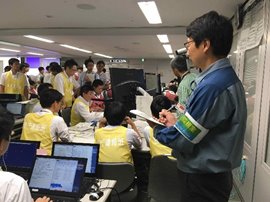TEPCO strengthens its independent nuclear safety oversight
Member Story
Vol 31 No 2 2021
26 July 2021
Takashi Sato, former Head of Nuclear Safety Oversight Office at TEPCO, explains how working with the Independent Nuclear Safety Oversight (INSO) working group members has helped TEPCO’s oversight capability go from strength to strength.
 Provide a brief overview of your organisation and the nuclear power plants you operate?
Provide a brief overview of your organisation and the nuclear power plants you operate?
TEPCO Nuclear Safety Oversight Office (NSOO) is the organisation’s internal independent nuclear safety oversight organisation. It was established in 2013, two years after the Fukushima-Daiichi accident. It is responsible for overseeing three different stages of the following plants:
• Fukushima Daiichi: the decommission of the (damaged) plant
• Fukushima Daini: the decommission of the plant
• Kashiwazaki Kariwa: the restart of the plant
How has WANO GL 2018-01 Independent Oversight helped your organisation strengthen Independent Oversight at your stations and headquarters?
Since the WANO PO&Cs (specifically the sections relating to OR.3 and CO.4) provide a high-level description of excellence for independent oversight, TEPCO NSOO decided to carry out a self-assessment by referring to and using WANO’s GL 2018-01 – Independent Oversight to obtain more practical standards.
Our oversight team used the self-assessment results during the INSO expert review during a WANO member support mission and corporate peer review. We could understand the clear vision and good practices delivered by the guideline and identified gaps in our oversight function, such as the quality of training and reporting.
Furthermore, measuring the effectiveness of oversight is very challenging. As the guideline provides a good explanation of how to measure INSO performance, we set our own KPIs based on the ideas outlined in the guideline.
What has been your strategy to address independent oversight at your organisation and plants?
As all three plants are in transition, we needed a well-balanced approach from our oversight function, both to cover routine tasks and project-type activity. In particular, the decommissioning of Fukushima Daiichi and the restarting of Kashiwazaki Kariwa are unique and we needed to be intrusive with FOAK (First of a Kind) key safety decisions and execution. At the same time, we still needed to observe daily routine tasks and find gaps in the key functional areas of a plant, such as operations, maintenance, radiation protection, etc.
How has TEPCO’s involvement in the INSO industry working group helped your organisation to improve?
Our oversight experts attended the industry working group meeting for the first time in Madrid in 2017. Regarding the benefits of attending this working group, there are many aspects where we have learnt industry good practices from other members. These include urgent challenges posed to oversight during the pandemic, common challenges posed to oversight within nuclear safety culture, and delivering the foundation of oversight through educational and training. Our people attend the INSO IWG because it has been an excellent opportunity to understand, learn from and meet oversight experts worldwide that have similar challenges.